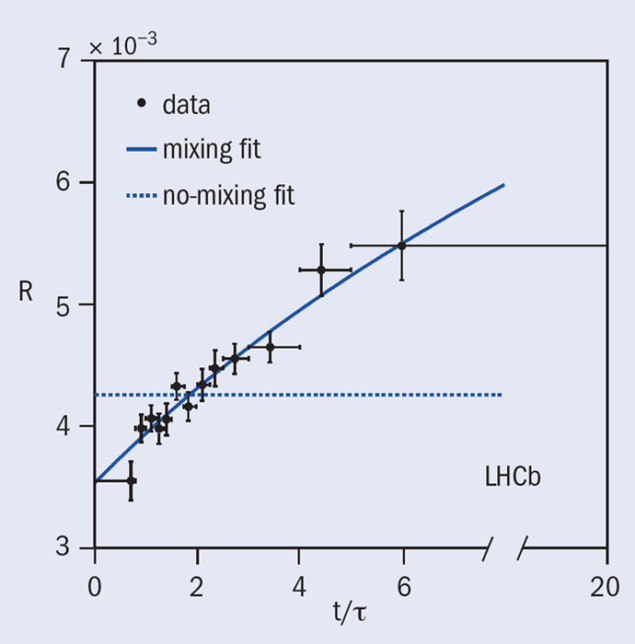The large cross-section for charm production at the LHC, and the geometry and instrumentation of the LHCb detector, provide samples of charmed hadrons far larger than those accumulated by previous experiments. These allow the Standard Model to be tested by studying various interesting phenomena such as CP violation and mixing in D0 mesons.
The electroweak force can cause D0 mesons (consisting of a charm quark and an anti-down quark) to transform into their antiparticle, D0 (anti-charm and down), and back. Such “flavour oscillations” or “mixing” have been observed and studied in detail in K0, B0 and Bs0 mesons. In the charm system, however, the period of the oscillations is so long – over one hundred times the average lifetime of a D0 meson – that although the BaBar, Belle and CDF collaborations have reported strong evidence of the effect, none of them has been able to claim an unambiguous observation.

One of the best channels to search for charm mixing is the decay D0 → Kπ. The initial flavour can be identified by the charge of the accompanying pion in the decay D*+→D0π+ or D*–→D0π–. The mixing effect appears as a decay-time dependence of the ratio R between the number of reconstructed “wrong-sign” (WS) and “right-sign” (RS) processes: D0→K+π– and D0→K–π+, respectively, and their charge conjugates. The WS process can proceed either by a Cabibbo-suppressed decay or through flavour oscillation followed by a favoured decay. In the absence of mixing, R will be constant as a function of the D0 decay time, t, while, in the case of mixing, it is predicted to be an approximately parabolic function of t. Determining R in bins of t therefore allows a measurement of the mixing parameters, while also cancelling many potential sources of systematic uncertainty.
The figure shows the ratio WS/RS, measured by the LHCb experiment, as a function of decay time, from a total of 36,000 WS and 8.4 million RS decays selected from the 1.0 fb–1 of data recorded in 2011. The horizontal dashed line shows the no-mixing hypothesis; the solid line is the best fit to data when mixing is allowed. The clear time-dependence observed excludes the no-mixing hypothesis by 9.1σ. The oscillation parameters are determined with uncertainties about a factor two smaller than in previous measurements.
Since the Standard Model predictions for the mixing parameters have large uncertainties, the next step will be to focus on cleaner observables to search for possible contributions from new physics. In particular, LHCb is now well placed to investigate whether there is a CP-violating contribution to the oscillations, in contrast to the Standard Model expectation. This will be achieved by studying charm mixing in this and other decay channels and exploiting the large increase in data following the successful 2012 LHC run.
Further reading
LHCb collaboration, LHCb-PAPER-2012-038, to be submitted to Phys. Rev. Lett.








